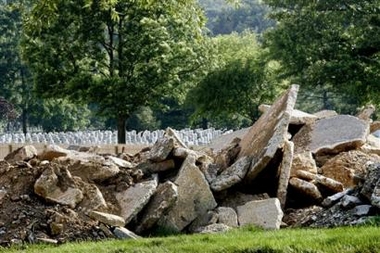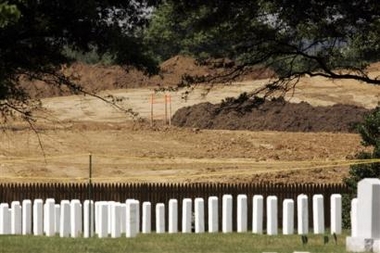Arlington National Cemetery is undergoing its first expansion in a decade.
The 12 million-dollar, 40-acre project is needed because of the large number World War Two veterans retiring. The expansion will allow the nation’s pre-eminent military cemetery to accommodate burials up to 2030.
As part of the project that began in May, 26-thousand graves are being added to the roughly 215-thousand already in place across the Potomac River from Washington.
An additional 77-thousand remains are in tombs for urns with cremated remains.
New roads and utilities also are being added to the cemetery — as well as a new stone wall as a boundary.
The last expansion was done in 1995, and involved ten acres.
Arlington Cemetery undergoes expansion
An excavator uproots trees. Rakes scrape the ground. A grinder turns limbs into mulch. Deer scramble for cover. For the first time in a decade, expansion is coming to the pre-eminent military burial ground in the United States. It means a major upheaval.
As a fawn dashes away, worker Scott Mills says, “I feel bad for them. And I hate tearing trees down. But this is for a good cause.”
Arlington National Cemetery is adding 26,000 graves to the roughly 215,000 already in place on the sweeping lawns across the Potomac River from the nation’s capital. An additional 77,000 remains are in columbariums, tombs for urns with cremated remains.
Matt Strittmatter, 45, of Richmond, Indiana, was making his fourth visit to the cemetery. He appreciated the bustle at what is normally a quiet place.
“It’s important for the families to have the option to bury their loved ones who’ve served here because of the sacrifice they made,” he said. “War affects everyone. It affects the families. They’ve earned the honor.”
The expansion means installing roads and utilities, building a new stone wall as a boundary, landscaping and creating 5,000 cremation niches. The work is necessary to accommodate the large number of veterans from World War II.
“Their population is of an age where the passing rate is about 1,200 a day. They are the largest population of daily burials,” said John Metzler, cemetery superintendent.
Arlington holds about 6,400 funerals a year, Monday through Friday. The peak year for deaths is expected to be 2008, when an estimated 30 funerals a day will be conducted.
The hilltop expansion, overlooking the Pentagon on one side and the Washington Monument on the other, was initially planned for 1990 but was delayed by money problems. It finally got under way in May.
The $12 million, 40-acre project will allow the cemetery to accommodate burials up to 2030. Two more expansions are planned, making enough space for ground burials for nearly six more decades.
Arlington was designated a military cemetery in 1864, during the Civil War. It is the final resting place for Presidents Kennedy and Taft, as well as Chief Justices Earl Warren and Warren Burger, 16 astronauts, and at least 170 men and women killed in Iraq and Afghanistan. Iraq veterans are buried here at the rate of two or three a week.
Bob Malte, 51, of Denver, brought his two kids — ages 8 and 9 — to see the cemetery “so they understand the significance of it. We want to honor people who’ve served our country and given their life for our country.”
The last expansion was done in 1995. It involved 10 acres.
Remnants of old buildings are shown in front of tombstones at Arlington National Cemetery, Friday,
June 17, 2005,in Arlington, Virginia, as workers prepare the landscape for the future graves of America’s
honored dead. Arlington National Cemetery is adding 26,000 graves to the roughly 215,000 already in place
on the sweeping lawns across the Potomac River from the nation’s capital.
An additional 77,000 remains are in columbariums, tombs for urns with cremated remains.
Tombstones at Arlington National Cemetery can be seen in front of land under preparation for cemetery
expansion Friday, June 17, 2005, in Arlington, Virginia. The cemetery is adding 26,000 graves to the
roughly 215,000 already in place on the sweeping lawns across the Potomac River from the nation’s capital.
An additional 77,000 remains are in columbariums, tombs for urns with cremated remains
Michael Robert Patterson was born in Arlington and is the son of a former officer of the US Army. So it was no wonder that sooner or later his interests drew him to American history and especially to American military history. Many of his articles can be found on renowned portals like the New York Times, Washingtonpost or Wikipedia.
Reviewed by: Michael Howard


